Have you ever noticed that what an ancient complex used as the symbol of Hanoi as well as printed on one side of the 100,000 VND note? The answer is the Temple of Literature – Vietnam’s oldest Imperial Academy under the feudal courts and the first national university. The temple was built in dedication to Confucian philosophy and still holds a spiritual significance to each generation of students and educators in Vietnam at present.
History of Temple of Literature
The temple was first built in 1070 in the Ly dynasty the reconstructed during 1225 – 1400 under the command of Tran Kings. Having strongly stood through centuries of wars, disasters, and major restorations, the temple still maintains its solemnly ancient look reflecting the architectural styles of various feudal dynasties and histories.
In 1070, according to the order of King Ly Thai Tong, the Temple of Literature was designed and built. The royal engineers had directed to place the statues of Confucius and his four famous disciples: Yan Hui, Zengzi, Zisi, and Mencius inside the structure. Besides, the picture featuring the Duke of Zhou was carved and 72 other Confucian scholars were painted. Temple was also where the Heir Apparent of the Imperial Throne and other princes studied.
In 1076, the Imperial Academy, Vietnam’s first university was established within the Temple of Literature to be the place of education for the kingdom’s royalty, nobles, and members of the elite class. However, in 1802, King Gia Long moved the capital to Hue and a new royal academy was placed. The Temple of Literature was still an educational symbol, but failed in prominence and became a district school.
In the period of the French colony, the Temple of Literature was recognized as a Historic Monument and put under restoration. Now, all the architectures still remain at their stunning classic beauty and the Temple becomes a famous tourist attraction in Hanoi.
Sections in Temple of Literature
The Temple structure resembles the Temple of Qufu, Shandong, China, Confucius’s birthplace. The layout includes an area of 54000 square meters with the Literature Lake, the Giam Park, and the courtyards surrounded by a brick wall. Four giant pillars rest in the front of the Entrance Gate, on each side of the pillars, laid two steles requiring horsemen to dismount.
The gate then leads to three pathways further into the complex. The path in the middle was used by the monarch, which above it hangs a large bronze bell. The left path was reserved for the Administrative Mandarins and the right path was occupied by the Military Mandarins.
First Courtyard
The first courtyard stretches over an area from the Great Portico to the Dai Trung (The Great Middle gate), which is halted by two minor gates: Dai Tai Mon (the Gate of Attained Talent) and Thanh Duc Mon (the Gate of Accomplished Virtue).
Second Courtyard
In the second courtyard lay a unique Vietnam architecture work since the 1805 and an emblem of present Hanoi – Khue Van Cac or the Pavilion of The Constellation of Literature. The Pavilion was built on four white stone stilts. On top of the stilts is a scarlet-painted house with two wooden circular windows and an elaborate roof. On two sides of the Khue Van Cac are the Suc Van Mon (Crystallization of Letters gate) and Bi Van Mon (Magnificence of Letters gate). As their name may suggest, those gates were designed to praise the beauty of literature in both its content and its form. A ray of topiaries representing the 12 Vietnamese zodiac animals run straight from the first to the second courtyard.
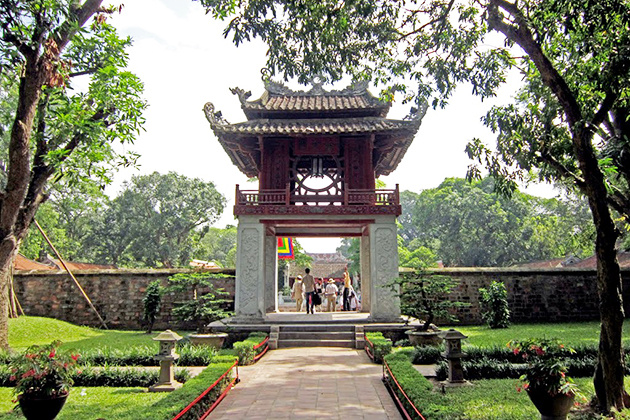
Third Courtyard
An outstanding feature of the third courtyard is the Thien Quang Tinh (Well of Heavenly Clarity). On either side of the well stands two great halls guarding the treasure of the temple.
Stelae of Doctors
In 1484, King Le Thanh Tong commanded the construction of 116 steles of turtles to honor talent and study. In ancient Vietnam, the turtle represented wisdom and longevity. Now, there are 82 steles remain. They were carved with the names and places of 1307 graduates in 82 triennial royal exams. Vietnamese believe that rubbing the turtles’ heads will bring luck and success to their academic path. The act has somehow become a tradition for each modern Vietnamese students going to the Temple praying for higher achievement in the upcoming important exams. Nevertheless, when realizing the stone has slowly been abraded, the Temple’s managers have placed a fence to prevent people from approaching the stone turtles.
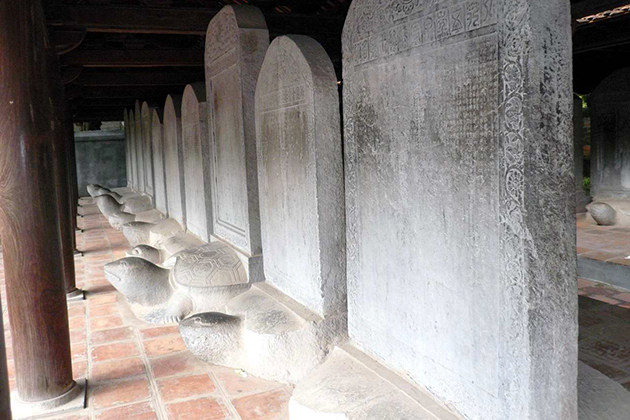
Fourth Courtyard
Entrance to the fourth courtyard is accessible through the Dai Thanh Mon, with two smaller gates on each side: the Kim Thanh Mon (Golden Sound Gate) and Ngoc Chan Mon (Jade Vibration Gate).
Altars to Confucius and his disciples
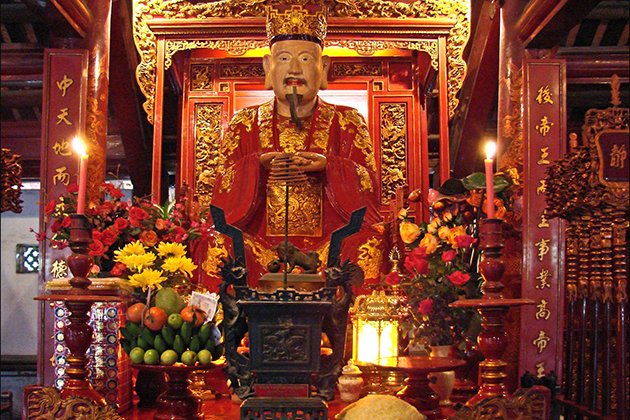
Two halls stand on either side of the ceremonial fourth courtyard, in the center places The House of Ceremonies (Dai Bai Duong). The large building is the Thuong Dien (Sanctuary of Dai Thanh), where people come to worship Confucius and his four disciples. A sanctuary is a place of worship for ten honored philosophers.
Fifth Courtyard
In 1076, King Ly Nhan Tong instructed the addition of an imperial academy to the complex as the fifth courtyard. This was where the future literate mandarins studied.
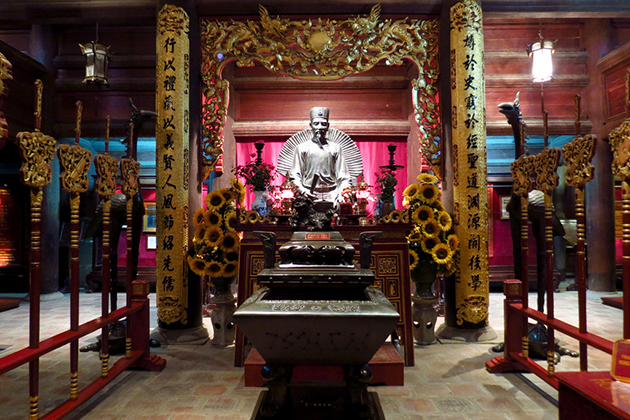
The upper floor is to honor three kings who contributed to the construction of the Temple: Ly Thai Tong (1023–1072), founder of the Temple, Ly Nhan Tong (1066–1127), founder of the Imperial Academy, and Le Thanh Tong (1442–1497), who commanded the building of the turtle stone stele of doctor laureates.
Highlights of the Temple of Literature
The Temple of Literature is definitely a must-see for any tourist desiring to explore Hanoi’s ancient beauty and culture. Below are the reasons why a trip to Hanoi’s Quoc Tu Giam is worth spending.
Discover the First National University of Vietnam
In nowhere in Vietnam there is a place that holds such significant value of education, literature, and academics as it does in Quoc Tu Giam. As Vietnam’s first university, the Temple has been chosen as Hanoi’s symbol of wisdom, talent, and study. One cannot explore the depth of Hanoi if skipping a visit to the very symbol of this thousand years old city.
Observe a Unique Examination Culture of Vietnam
Every year, before the university entrance exam – a milestone for each student in Vietnam – is conducted, there is a tradition that high-school students would come to Quoc Tu Giam praying for success in the exams. Students often come to pay respect to the Confucian philosophers, speaking of their wish to pass the exam in flying color. It is also common for them to purchase lucky Norm script letters written by calligraphists. The letter can imply success, high mark, talent, achievement, or effort and is written in red silk paper or carved in a necklace’s pendant.
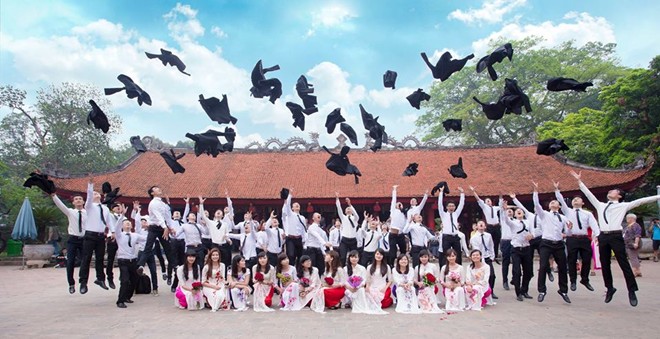
Behold the Beauty of Vietnamese Female Students in their Traditional Dress
The spring of each year is also the time for university students to prepare for their yearbook photo – a keeper of their memories with each other. Visiting the Temple of Literature in this time, tourists are expected to find many beautiful Vietnamese girls in the graceful traditional ao dai, which they do not dress usually today except on special occasions. Ao dai and Quoc Tu Giam – two symbols of Hanoi combine can draw such outstanding classic beauty. Temple of Literature is also an indispensable destination within any student tours as well as Vietnamese school trips.
Preserves the Writings of Nom Script
This is logographic writing used to write the Vietnamese language in ancient times. Now, the letter of Nom script was used for spiritual purposes only. In Vietnam New Year, Nom calligraphist masters often sit beside the gate of Quoc Tu Giam, writing Nom letters on a silk paper, making them look like a painting. People tend to purchase them to decorate their house as a symbol of fortune or present them as a gift to friends, implying that they pray for their friend a new year of success, too.
Ceremonies & Worshipping
Special ceremonies are held in each season to honor Vietnam’s ancient scholars. Worshippers often dress gorgeously in ceremonial traditional clothes, dancing, chanting, and offering incense and fruits to the altar. Visitors should not leave their cameras at home, or else we could miss the chance to records the interesting rituals of the ceremony.
How to Get to the Temple of Literature
The Temple of Literature is located on the Van Mieu St, Dong Da District. The complex is 1km from Hoan Kiem Lake and 1.2 km from the Mausoleum of Ho Chi Minh. Most people travel to the Temple by bike, with the parking fee is 5000 Vietnamese dong per bike. However, there are also plenty of buses that offer a stop at the main entrance like the 02, 23, 32, 38, and 41.
Entrance Access to Temple of Literature
- The Temple is opened for visitors in Hanoi tours every day of the week, the opening hours can vary in different seasons.
- In hot season (15/4 to 15/10): From 7h30 to 17h30
- In the cold season (16/10 to 14/4): From 8h00 to 17h00
- Entrance Fee: 30,000 VND per person

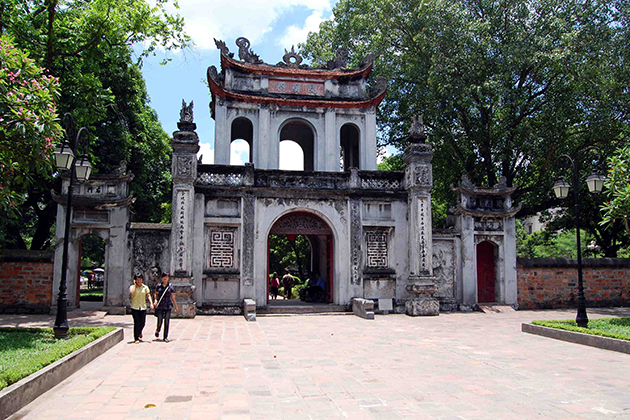
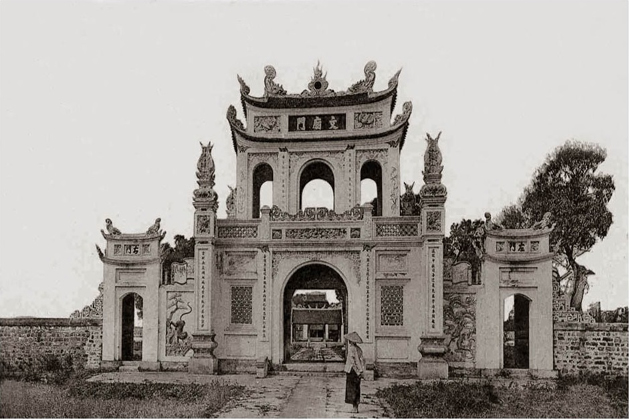


It’s indeed historical.l really would like to know more by visiting the temple.
Temple of Literature (Van Mieu) and Royal University (Quoc Tu Giam)
The Temple of Literature-Royal University is surrounded by 4 streets (Quoc Tu Giam, Van Mieu, Nguyen Thai Hoc and Ton Duc Thang), in Hanoi City. The Temple of Literature, which is dedicated to Confucius and other Confucian scholars, was built in 1070 during the Ly dynasty. It occupies an area 75 metres in width and 350 metres in length. It was built mainly with wood and baked bricks. Subjected to the erosion of weather and time, and ups and downs of history, it underwent repairs on many occasions and, therefore, could not retain its original architectural design, except for the main buildings.
In August 1070 King Ly Thanh Tong ordered to install statues of Confucius and of Tu Phoi brilliant disciples of Confucius) as also the portraits of 72 sages. Later, Emperor Gia Long (Nguyen dynasty) had the Khue Van Cac (Literature Constellation Pavilion) and Khai Thanh temple built in 1805. The main building the Temple of Literature is the Dai Thanh Hall dedicated to Confucius. Dai Thanh Mon, that is the gate to Dai Thanh Hall, is quite modest in form, but has a large space, with many trees several hundred years old. Behind the Dai Thanh Hall is the Khai Thanh temple where Confucius’s parents are worshipped.
The above buildings and the other structures – the three-entrance gate, the Thien Quang Tinh pond, the Dai Trung Man (Intermediate gate) – are all arranged along a North-South axis.
Quoc Tu Giam, which was built in 1076 was located just behind the Temple of Literature. This was the first University of Viet Nam, which was initially designed for members of the Ly royal family. Later, children of court officials and gifted students of commoners were also recruited. This 800- year-old higher educational institution had:
– a lecture hall;
– living quarters which could accommodate 300 students (6 rows of houses on either side, each with 25 rooms, 2 students in each room) and study rooms;
– the area for discussions on literature
– the area for stone steles inscribed with the names of laureates of court exams (14 oldest steles were erected in 1484, during the reign of King Le Thanh Tong, while the last one was erected in 1780). The steles reflect the history of Viet Nam’s education (up to now only 82 steles have been preserved).
– a library.
As the Nguyen emperors established a new Royal Capital in Hue, the second temple of literature was built there in 1808 and completed in 1865, with a structure similar to the Hanoi Temple of Literature. In the early 1990s, a house to shelter the stone steles was built.